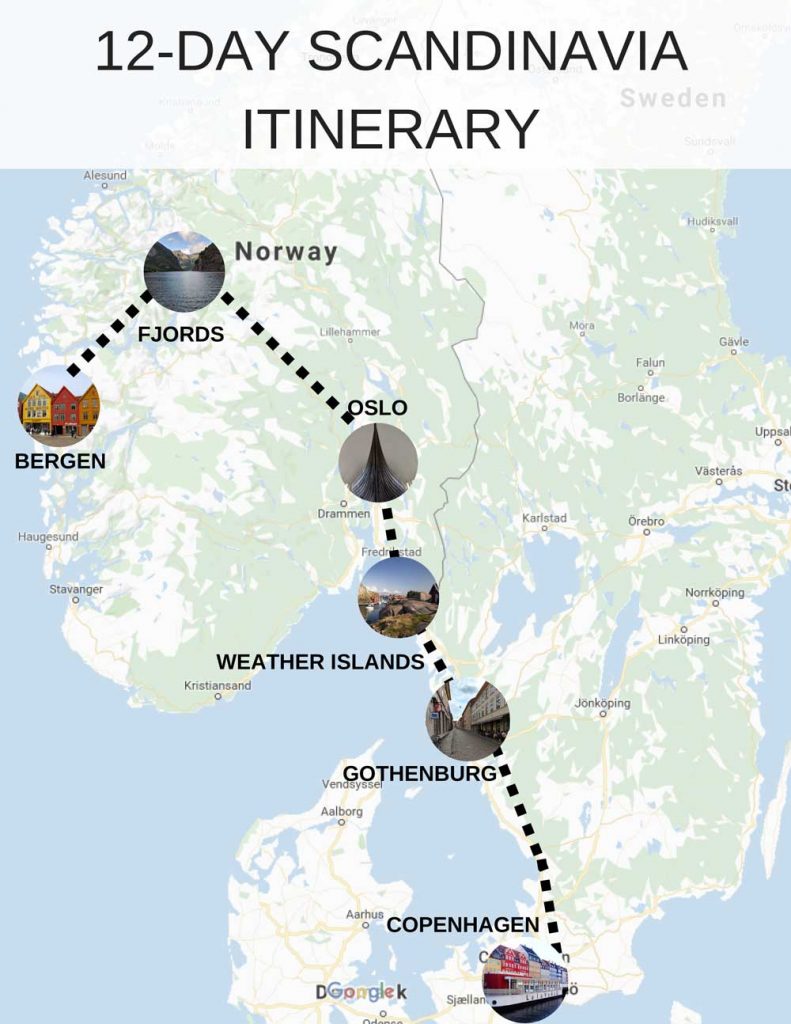
Scandinavia, a region steeped in Viking lore, breathtaking natural beauty, and a reputation for progressive societies, beckons travelers with an irresistible allure. From the dramatic fjords of Norway to the vibrant cityscapes of Denmark and the vast wilderness of Sweden, these countries offer a captivating blend of history, culture, and adventure. This comprehensive itinerary will guide you through a memorable Scandinavian journey, delving into their rich past, highlighting their most iconic attractions, and equipping you with essential travel tips for an unforgettable experience.
A Glimpse into the Past: Echoes of Vikings and Kingdoms
The history of Scandinavia is a tapestry woven with threads of ancient myths, formidable warriors, and the rise of powerful kingdoms. The Viking Age (8th to 11th centuries) remains a defining chapter, with Norse seafarers exploring, trading, and raiding across Europe. Their longships, intricate craftsmanship, and complex mythology continue to inspire awe and fascination.
Related Articles about Beyond the Fjords and Northern Lights: A 1600-Word Scandinavian Odyssey:
- Standing Tall: Your Essential Guide to Visiting Christ the Redeemer
- Egypt: A Journey Through Time, Wonder, and Unforgettable Experiences
- Madagascar: The Ultimate Guide to the Eighth Continent
- Austria: A Symphony of Imperial History, Alpine Majesty, and Cultural Charm
- Argentina: A Tapestry of Wonders – Unveiling its Best Tourist Attractions
Following the Viking era, the three core Scandinavian nations – Denmark, Norway, and Sweden – gradually consolidated their power, experiencing periods of both cooperation and conflict. The Kalmar Union (1397-1523), a personal union of these kingdoms under a single monarch, marked a significant, albeit ultimately unsuccessful, attempt at unification.
The 19th century saw the rise of National Romanticism, a cultural movement that celebrated Scandinavian heritage and identity, influencing art, literature, and architecture. In more recent times, these nations have emerged as pioneers in social welfare, environmentalism, and gender equality, shaping their modern-day appeal.
Embarking on Your Scandinavian Odyssey: A Multi-Country Itinerary
This itinerary is designed to provide a balanced experience, blending iconic sights with opportunities for deeper cultural immersion. It can be adapted to your interests and available time, but a typical exploration might span 10-14 days.
Days 1-3: Copenhagen, Denmark – The Royal Capital
Begin your journey in the charming capital of Denmark, Copenhagen. This city seamlessly blends historic grandeur with modern design and a relaxed, bike-friendly atmosphere.
-
Main Attractions:
- Tivoli Gardens: One of the world’s oldest amusement parks, a magical escape with beautiful gardens, thrilling rides, and enchanting entertainment, especially magical at night.
- Nyhavn: The iconic colorful harbor, a picturesque waterfront lined with historic townhouses, perfect for a leisurely stroll and enjoying a traditional Danish open-faced sandwich (smørrebrød).
- The Little Mermaid Statue: A symbol of Copenhagen, inspired by Hans Christian Andersen’s fairy tale. While small, it’s a must-see for its literary significance.
- Rosenborg Castle: A stunning Renaissance castle housing the Danish Crown Jewels and royal artifacts, set amidst the beautiful King’s Garden.
- Christiansborg Palace: The seat of the Danish Parliament, the Royal Reception Rooms, and the Royal Stables.
- Designmuseum Danmark: Explore the rich history of Danish design, from furniture to fashion.
-
Nearby Hotels:
- Luxury: Hotel D’Angleterre, Nobis Hotel Copenhagen.
- Mid-Range: Scandic Palace Hotel, Axel Guldsmeden.
- Budget-Friendly: Generator Copenhagen, Steel House Copenhagen (hostel).
-
Local Food: Smørrebrød (open-faced sandwiches), Frikadeller (meatballs), Wienerbrød (Danish pastries), and a hearty herring dish.
-
Transportation: Copenhagen is incredibly walkable and bike-friendly. The public transport system (metro, buses, S-trains) is efficient. Consider purchasing a Copenhagen Card for free public transport and entry to attractions.
Days 4-7: Oslo, Norway – Gateway to the Fjords
A scenic train journey or a short flight will take you to Oslo, Norway’s vibrant capital, nestled between rolling hills and the Oslofjord.
-
Main Attractions:
- Vigeland Sculpture Park: A unique and thought-provoking park featuring over 200 sculptures by Gustav Vigeland, depicting the human life cycle.
- The Viking Ship Museum (closed for renovation until 2026): Formerly home to remarkably preserved Viking ships, a testament to Norway’s seafaring past. Check for temporary exhibitions.
- Fram Museum: Learn about Norwegian polar exploration and see the actual ship "Fram," which carried Nansen and Amundsen on their expeditions.
- Kon-Tiki Museum: Discover the adventures of Thor Heyerdahl and his Kon-Tiki raft expedition.
- Akershus Fortress: A medieval castle and fortress offering panoramic views of the harbor and city.
- Opera House: A modern architectural marvel, designed to resemble an iceberg emerging from the water, where you can walk on its roof.
-
Nearby Hotels:
- Luxury: The Thief, Grand Hotel Oslo.
- Mid-Range: Amerikalinjen, Thon Hotel Rosenkrantz Oslo.
- Budget-Friendly: Anker Hotel, Saga Poshtel Oslo Central (hostel).
-
Local Food: Fårikål (mutton and cabbage stew, Norway’s national dish), Rakfisk (fermented fish – an acquired taste!), Laks (salmon – incredibly fresh and delicious), and brown cheese (brunost).
-
Transportation: Oslo has an excellent public transport system (T-bane metro, trams, buses, ferries). Consider an Oslo Pass for free public transport and museum entries.
Days 8-10: Norwegian Fjords – Majestic Waterways
No Scandinavian trip is complete without experiencing the awe-inspiring Norwegian Fjords. This segment is best experienced as an overnight trip from Oslo or as a standalone adventure.
-
Main Attractions:
- Geirangerfjord: A UNESCO World Heritage site, renowned for its dramatic cliffs, cascading waterfalls (Seven Sisters, Suitor), and emerald waters.
- Nærøyfjord: The narrowest fjord in the world, a breathtakingly beautiful and dramatic waterway.
- Pulpit Rock (Preikestolen): A famous cliff plateau offering spectacular views over the Lysefjord. Requires a hike.
- Kjeragbolten: A boulder wedged between two cliffs, a challenging hike and a popular photo opportunity.
- Flåm Railway: A scenic train journey through stunning mountain landscapes, considered one of the most beautiful in the world.
-
Recommended Base Towns: Flåm, Gudvangen, Bergen (if extending your trip).
-
Nearby Hotels:
- Luxury: Hotel Union Øye (near Geirangerfjord).
- Mid-Range: Fretheim Hotel (Flåm), Stalheim Hotel (near Gudvangen).
- Budget-Friendly: Numerous guesthouses and hostels in smaller fjord towns.
-
Local Food: Freshly caught seafood, lamb dishes, and local berry desserts.
-
Transportation: The "Norway in a Nutshell" tour is a popular way to experience the fjords, combining train, bus, and ferry journeys. Renting a car offers flexibility but be prepared for narrow, winding roads.
Days 11-14: Stockholm, Sweden – The Venice of the North
Conclude your journey in Stockholm, Sweden’s capital, spread across 14 islands, offering a unique blend of history, culture, and natural beauty.
-
Main Attractions:
- Gamla Stan (Old Town): A remarkably preserved medieval city center with cobblestone streets, colorful buildings, and the Royal Palace.
- Vasa Museum: Home to the incredibly preserved Vasa ship, which sank on its maiden voyage in 1628. A truly impressive sight.
- Skansen: The world’s first open-air museum and zoo, showcasing historical Swedish buildings and traditions, with a focus on Nordic animals.
- Djurgården: A beautiful island housing many of Stockholm’s most popular attractions, including Skansen, the Vasa Museum, and the ABBA Museum.
- City Hall: A magnificent building where the Nobel Prize banquet is held, offering stunning views from its tower.
- ABBA The Museum: A fun and interactive tribute to the iconic Swedish pop group.
-
Nearby Hotels:
- Luxury: Grand Hôtel Stockholm, The Sparrow Hotel.
- Mid-Range: Hotel Diplomat, Story Hotel Riddargatan.
- Budget-Friendly: Generator Stockholm, Castanea Old Town Hostel.
-
Local Food: Köttbullar (meatballs with lingonberry jam), Gravlax (cured salmon), Surströmming (fermented herring – again, an acquired taste!), and Kanelbullar (cinnamon buns).
-
Transportation: Stockholm has an excellent public transport network (Tunnelbana metro, buses, trams, ferries). Consider a Stockholm Pass for free public transport and entry to attractions.
Essential Travel Tips for Your Scandinavian Adventure
- Currency: Denmark uses the Danish Krone (DKK), Norway uses the Norwegian Krone (NOK), and Sweden uses the Swedish Krona (SEK). Credit cards are widely accepted, but it’s good to have some local currency for smaller purchases.
- Language: While English is widely spoken, learning a few basic phrases in each language (e.g., "Hello," "Thank you") is always appreciated.
- Tipping: Tipping is not as customary as in many other countries. Service charges are usually included in the bill. If you receive exceptional service, a small tip is appreciated but not expected.
- Embrace the "Lagom" (Sweden) and "Hygge" (Denmark) Philosophy: These concepts emphasize well-being, coziness, and contentment. Take time to relax, enjoy good company, and appreciate the simple pleasures.
- Book Accommodation and Transport in Advance: Especially during peak season, popular hotels and train routes can book up quickly.
- Pack Layers: Scandinavian weather can be unpredictable. Pack layers that you can add or remove as needed. Include waterproof and windproof outer layers.
- Comfortable Walking Shoes: You’ll be doing a lot of walking, so comfortable footwear is essential.
- Respect the Environment: Scandinavia is known for its pristine nature. Be mindful of your impact and follow local guidelines for waste disposal and conservation.
- Consider Travel Insurance: It’s always wise to have travel insurance to cover unforeseen circumstances.
- Stay Connected: Wi-Fi is generally excellent and readily available in hotels, cafes, and public spaces. Consider a local SIM card or an eSIM for continuous connectivity.
The Best Time to Visit Scandinavia
The "best" time to visit Scandinavia depends on your priorities:
- Summer (June-August): The most popular time, offering long daylight hours (midnight sun in the north), pleasant temperatures, and lush landscapes. Ideal for outdoor activities and exploring the fjords. Expect higher prices and more crowds.
- Spring (April-May): A beautiful time to visit as nature awakens. Temperatures are mild, and the crowds are smaller than in summer. Flowers are in bloom, and the cities are vibrant.
- Autumn (September-October): Offers stunning fall foliage, crisp air, and fewer tourists. The cities are cozy, and the landscapes are painted in warm hues.
- Winter (November-March): For those seeking snow, skiing, and the magical Northern Lights (Aurora Borealis), winter is the time. Cities are beautifully decorated for the holidays, but daylight hours are short, and temperatures are cold. The Northern Lights are most visible in the northern parts of Norway and Sweden.
Savoring the Flavors: Local Cuisine
Scandinavian cuisine is characterized by its fresh, seasonal ingredients, with a strong emphasis on seafood, berries, and root vegetables.
- Seafood: From the salmon of Norway to the herring of Denmark and Sweden, fish is a staple. Enjoy it grilled, smoked, cured, or in traditional dishes.
- Meat Dishes: Swedish meatballs (köttbullar), Danish frikadeller, and Norwegian fårikål are hearty and flavorful.
- Dairy: Brown cheese (brunost) is a unique Norwegian delicacy with a sweet, caramel-like flavor.
- Baked Goods: Don’t miss the opportunity to indulge in Danish pastries (wienerbrød), Swedish cinnamon buns (kanelbullar), and various rye breads.
- Berries: Scandinavia is abundant with delicious berries – lingonberries, blueberries, raspberries – often used in jams, desserts, and sauces.
Seamless Travel: Transportation Options
- Flights: Major international airports in Copenhagen, Oslo, and Stockholm offer excellent connectivity. Within Scandinavia, budget airlines and national carriers provide frequent flights between cities.
- Trains: The rail networks in all three countries are efficient, comfortable, and offer stunning scenic routes, especially in Norway and Sweden. Consider a Eurail pass if you plan extensive train travel.
- Ferries: Essential for exploring the archipelagos and fjords. Regular ferry services connect coastal towns and islands.
- Buses: A good option for reaching smaller towns and rural areas not served by trains.
- Car Rental: Offers the most flexibility, especially for exploring the countryside and fjords. However, be prepared for narrow roads, parking challenges in cities, and potentially high fuel prices.
- Public Transport within Cities: All major Scandinavian cities boast excellent public transportation systems (metro, trams, buses, ferries), making it easy to get around without a car.
Embark on this Scandinavian odyssey, and you’ll discover a region that captivates the senses, nourishes the soul, and leaves you with memories to cherish for a lifetime. From the whispers of ancient sagas to the embrace of modern innovation, Scandinavia awaits your exploration.








